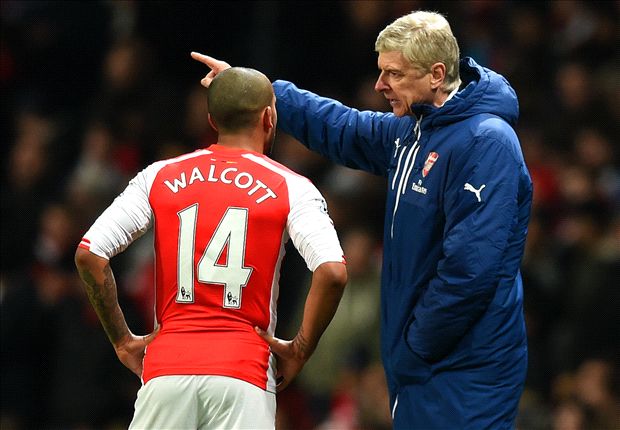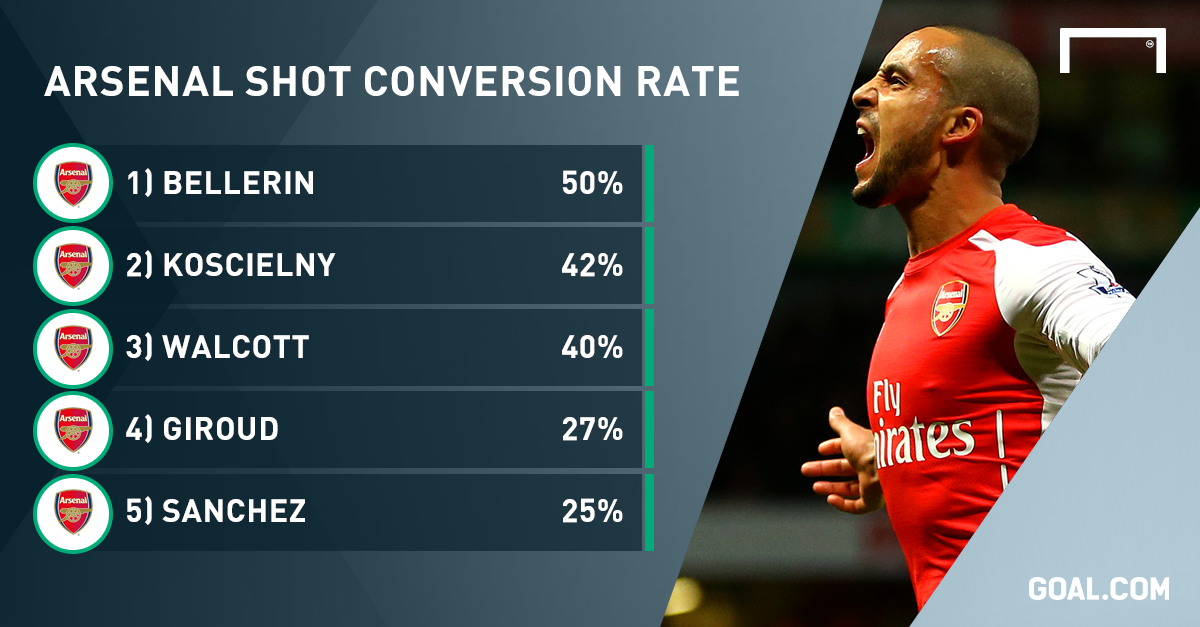
THE DOSSIER: The jet-fueled winger has been used sparingly since returning from injury, but his pace and movement could inject fresh impetus into the Gunners' counter-based setup
Though both clubs appear somewhat vulnerable at present, neither Manchester United nor Arsenal were particularly overjoyed to be drawn against each other in the FA Cup quarter-finals.
Both teams are now favourites to win the competition. The Gunners are, of course, the defending champions and boast the best goal difference in the Premier League since the turn of the year, while United are unbeaten at home to the north Londoners since 2006.
Recently, the two teams have become particularly adept at doing just enough to win – Louis van Gaal’s men are proficient at being only marginally less miserable than their opponents, while five of Arsenal’s last eight league wins have come by just a one-goal margin – but the hosts go into Monday’s clash in the knowledge that they have consistently dominated their opponents at Old Trafford.
The Gunners have lost nine of their last 10 visits, drawing the other, and have only managed to score more than once on one occasion – though, that day, they also conceded eight times – leaving them with a goal difference of -18 in the last nine years. But Arsenal have faced similar hoodoos already this season and prevailed, and Arsene Wenger need only look at how his side performed on their last visit to Manchester to begin plotting United’s downfall.
In January, the Gunners travelled to the Etihad Stadium to face an in-form City side who had averaged nearly three goals per game against Wenger’s men in their last seven meetings, culminating in a 6-3 hammering last season. However, a change in tact saw the side pick up three points, as well as a clean sheet, and has been the basis for a solid, if somewhat unspectacular, start to 2015.

That match, a 2-0 victory secured by goals from Santi Cazorla and Olivier Giroud, remains the zenith for the re-shaping of Arsenal’s style. Usually noted for their patient passing football, the Gunners have started to relinquish their stranglehold on possession. In their nine league matches this year, they have averaged just 49.7 per cent possession compared to 57% in the first 19 games of the campaign.
Against City, the 35.3% they mustered was their lowest share of the ball since Opta began recording statistics (back in August 2003). But they won, and convincingly. Save for a shock loss to Monaco, the team have begun playing more and more on the break, transitioning between defence and attack increasingly rapidly, and there is more thrust and drive to the side since they have been liberated from their old, often plodding passing game.
Ironically, there has been almost a role reversal between United and Arsenal since their meeting at the Emirates in November. Back then, it was Van Gaal’s men who played on the break, slicing through a too-high, too-cavalier back-line, while the Gunners toiled to break down their opponents despite their overwhelming possession.
For Wenger it was the epiphany he needed; his side have not matched their possession figures that day in any of the matches that have followed, instead setting up to play on the break and happy to let their opponents have the ball. In the meantime, United have gone the other way, now leading the Premier League for both possession and pass success – though the quality of the football currently being played, so laboured and unimaginative, has been heavily criticised.

There has been one curious absentee from Wenger’s reimagining of Arsenal, though, and that is Theo Walcott. Perhaps the French coach has finally learnt his lesson and is merely granting the winger the snail-paced rehabilitation he needs after such a lengthy lay-off, but it is hard to escape the notion that he has been under-utilised in a team that is finally set up to get the best out of his lightning-fast skillset.
The England international, available throughout 2015 and named in every squad Wenger has picked, has been reduced to a cameo role in this new-look Arsenal even though he ought to benefit most from the change in style. His blend of on-the-shoulder movement, darting runs and frightening speed has previously been a little too direct for the club’s more measured style – which, in turn, had opposition defences retreating and depriving Walcott of the space in behind that he thrives on.
But the added emphasis on counterattacking plays to his strengths – this is a player, after all, who Lionel Messi described as “one of the most dangerous players I’ve ever played against” as he continually, devilishly broke against the Barcelona back-line – and he is capable of dishing out the fast-breaking sucker-punches Arsenal used to be on the receiving end of so often, especially at Old Trafford.
Walcott, in fact, is one of just two current Arsenal players to have scored at the home of United, while goals at White Hart Lane, Stamford Bridge, the Etihad Stadium and Wembley would normally mark him out as a player for the big occasion. Yet, despite his clutch finishing and improving goalscoring record, there is a sense that Wenger cannot trust the winger quite as much as he needs to.

While Walcott’s pace-infused movement has the potential to wreak havoc in a counter-orientated side, such a gameplan generally requires discipline and defensive work rate – not something the 25-year-old is noted for. He has never made more than 18 tackles in a single season, while his interception tally is similarly low. But that is not a problem Danny Welbeck has ever had.
The former United starlet, returning to the club that made him for the first time, has made more tackles in two seasons than Walcott has in his entire career, and has already won possession 53 times this term alone. Away to Tottenham, he played more like a second full-back than a winger. As such, perhaps it is easy to see why Wenger has more faith in the leggy, defence-conscious forward.
Despite Welbeck’s pleas to play as a centre-forward, and Wenger’s own public appreciation of his ability through the middle, he has nevertheless treated the striker just as United did – a defensive option capable of shutting down a flank. Such traits could be needed against the Red Devils and in-form winger Ashley Young, but also rob Arsenal of an explosive, goalscoring threat. Welbeck is unlikely to ever be prolific out wide.
While Arsenal’s change in emphasis has reaped rewards - and points - they have not been especially convincing or exciting. Walcott’s inclusion would enhance, not dilute, the new counter-punching style, even if Wenger might consider it a risky option, and that could be decisive at Old Trafford.
A barely motivated Newcastle outfit engineered and wasted countless counters in midweek. Just imagine what Walcott could do.
